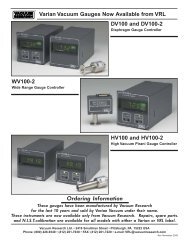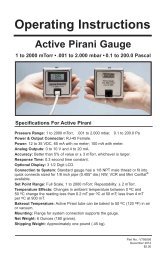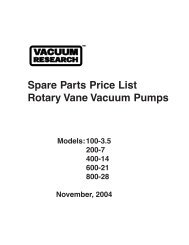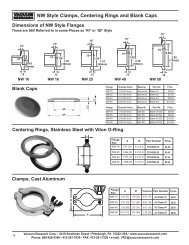24VDC Transmitter Manual - Vacuum Research Corp.
24VDC Transmitter Manual - Vacuum Research Corp.
24VDC Transmitter Manual - Vacuum Research Corp.
You also want an ePaper? Increase the reach of your titles
YUMPU automatically turns print PDFs into web optimized ePapers that Google loves.
adjust the “Span” pot until the display reads that pressure.<br />
For example, if you are in Pittsburgh and you are at 636 ft. altitude on a<br />
standard day the following is true: at sea level the Std. Barometer is 29.92<br />
in Hg = 760 Torr (29.92 X 25.4 = 759.968 Torr).<br />
This is the altimeter setting for an aircraft, so that at landing the plane’s<br />
altimeter reads 636 ft. (At sea level the altimeter reads 000.)<br />
Multiply the station pressure by 25.4 to convert inches Hg. to Torr and<br />
adjust the span to read the calculated number which in the above example<br />
is 743 Torr.<br />
To obtain this information, look in the phone book under US Government,<br />
Transportation Dept., and call the number for “Pilot One Call Briefing.”<br />
Ask for the “Station Pressure”. Tell them your application is for industrial<br />
calibration purposes.<br />
Atmosphere to 30 in. Hg Diaphragm <strong>Transmitter</strong> (See pg.<br />
11 for circuit board map)<br />
Zero adjustment is made by exposing the transducer to atmospheric pressure<br />
and setting the “Offset” pot to read 000 on the meter.<br />
Pump the transducer to a vacuum that is at least 2 mmHg (Torr) absolute<br />
or lower. It need not be known as long as it is less than the 2 mm Hg.<br />
Obtain the correct barometric pressure and adjust the pot marked “Span”<br />
to read the barometric pressure.<br />
To obtain the correct barometric pressure call the “FAA Pilot one call briefing”<br />
line at your local airport. Ask for the Station Pressure, not the<br />
Altimeter setting.<br />
Gauge Tube Wiring<br />
The gauge tube can be checked with an ohmmeter between pins 1 and 5<br />
to verify that the sensor is good. Generally, the reading is less than 2.5<br />
ohms if good; 900 ohms if the sensor is broken.<br />
The actual readings for each type of tube should be as follows:<br />
SENSOR PINS 1 TO 5<br />
BLACK AND GREEN WIRE<br />
APPROXIMATE RESISTANCE<br />
100 mT 2.4 Ohms<br />
2000 mT 2.1 Ohms<br />
20 Torr 1.3 Ohms<br />
14








